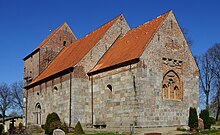Laurentiuskirche (Munkbrarup)
The Laurentiuskirche is a Romanesque stone church in Munkbrarup built from carefully hewn granite blocks .
history
The parish of Munkbrarup was first mentioned as Holdernes-Brotorp in 1209 , when the church was incorporated into the Cistercian monastery of Rüde . The Laurentiuskirche itself already existed at this time. It is named after Saint Lawrence of Rome . It was built on the model of the Söruper Marienkirche and originally did not have a tower, but a semicircular apse . The south portal is modeled on the Petri portal of the Schleswig Cathedral . A lion fight scene can be seen on the apex of the pillars. The handover of the keys by Christ to Simon Peter is shown above the portal . The north portal, the women's door, also from the time it was built, is much simpler.
In the 15th century the apse was demolished and the stones used for the construction of the tower and vestibule. The blind niche around the window group of the late Gothic east wall is decorated with parts of the cornice and pieces of combatants with heads from the apse. In 1565 the church burned down. The residents now used the dilapidated church of the Rudekloster in Glücksburg, which was secularized in 1557. When Johann the Younger became the new sovereign in 1582, the residents asked for one or the other church to be renovated. Duke Johann had the Rudekloster demolished in order to build his Glücksburg Castle . Before that he commissioned his architect Nikolaus Karies to renovate the Munkbraruper church. The church received its present cross vault. During the restoration in 1936, the church was given its current appearance. An attempt was made to reconstruct the original Romanesque exterior view. Inside, neo-Gothic changes from 1899 and the galleries were removed, so that the cross vault, which was drawn in in 1582, determines the impression of the space.
Furnishing
From the time it was built, the Laurentiuskirche has a baptismal font depicting a fight between four men and a lion, watched by a king from the battlements of his castle. Its style suggests that it was made in the same building works as the portal.
The brick cafeteria also dates from the time the church was built. The original altarpiece has been on the north wall since 1937. In a Renaissance case it contains a small alabaster house altar from the workshop of Cornelis Floris II from 1560. The large triumphal cross comes from the former Rudekloster. It had to be shortened a bit to fit into the small village church. The pulpit is a work from the workshop of the Flensburg carver Heinrich Ringerink .
Three paintings from the second half of the 17th century show Pastor Fabricius, 1668–1677 pastor in Munkbrarup, painted by J. Holtz, the family of Pastor Valentin, who was in Munkbrarup from 1676–1706, and Salome with the head of John the Baptist by a Glücksburg court painter.
The baroque organ front was created by Johann Daniel Busch in Itzehoe in 1740; the work was built by Marcussen & Søn in 1858 .
Legend of the building of the Munkbraruper church
According to legend, the church was initially to be built in Rüde , but where it was repeatedly destroyed during construction. So it was decided to build it in Munkbrarup.
It is also reported that the builder who was supposed to build the church failed to complete it on the promised time. Shortly before the deadline expired, a goblin approached him and offered him his services. The little man seemed to be boasting, as he declared, that he wanted to finish the church in no time. But the builder should belong body and soul to the goblin for the promised service, should he not have guessed his name before the end of the construction. The builder, who had listened in disbelief to the goblin's talk, finally agreed. The builder thought that the goblin would surely mention his name to the other workers on the church building site. If the goblin didn't tell him his name beforehand, he would get the name from him. But the goblin worked at night, very quickly and without help.
One day before the church was supposed to be finished, the builder walked sadly across the fields because he still didn't have the name. Then he passed a hill and from there heard a small child crying in the ground. He paused, listened, and heard the mother rebuking the child. It should be silent. In the evening his father Sipp would come and bring a Christian with him. As soon as he heard this, the builder hurried to the church, where the goblin was just about to put the last stone in the wall and shouted to him from afar with delight: "Good morning, Sipp!" The goblin immediately got into the grass and threw it Stein aside and drove away.
The hole that had remained in the church wall due to the missing stone could not be closed afterwards. A bricklayer who tried once fell sick immediately. A window was put in place of a stone. The goblin allowed this.
The legend is obviously reminiscent of the fairy tale of Rumpelstiltskin .
See also
literature
- Claus Rauterberg and Friedhelm Kummetz: Churches in fishing and their art treasures. Friedrich Wittig, Kiel 2001, ISBN 3-8048-4468-5
Individual evidence
- ^ Heiko KL Schulze: The buildings of the Rudekloster in Glücksburg in the 13th century. On the architecture of the Cistercians in Northern Germany. In: "Think!" Journal for the preservation of monuments in Schleswig-Holstein. Volume 13 (2006), Boyens Buchverlag, Heide; Pp. 40-48; P. 41
- ↑ Leveringsliste (pdf, accessed December 7, 2018)
- ↑ Cf. Gundula Hubrich-Messow: Legends and fairy tales from fishing. Husum 1987, pages 35 and 78
Web links
Coordinates: 54 ° 48 ′ 8.7 " N , 9 ° 33 ′ 44.1" E



